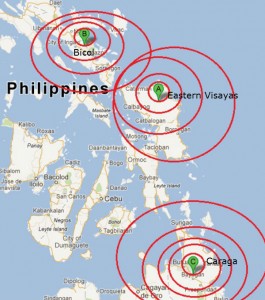No-fly, no-sail zones set for South Korea satellite launch
 The regions of Bicol, Eastern Visayas and Caraga are to be “no-fly, no-sail” zones as a precautionary measure when South Korea conducts a satellite launch on Oct. 26, the National Disaster Risk Reduction Council (NDRRMC) announced Tuesday.
The regions of Bicol, Eastern Visayas and Caraga are to be “no-fly, no-sail” zones as a precautionary measure when South Korea conducts a satellite launch on Oct. 26, the National Disaster Risk Reduction Council (NDRRMC) announced Tuesday.
The restriction is “from sea level to infinity… it will be a no-fly, no-navigation zone,” said Benito Ramos, the NDRRMC executive director, at a multi-agency meeting at Camp Aguinaldo.
The area covered includes the entire Bicol region, Samar and Leyte in the Eastern Visayas, and Surigao del Norte, Surigao del Sur, and Siargao and Dinagat islands in the Caraga region.
South Korea has announced the launch of its 3rd Science and Technology Satellite-2 (STSAT-2) aboard the Korea Space Launch Vehicle-1 (KSLV-1) on Oct. 26 from the Naro Space Center on Naro Island, Goheung County, South Jeolla, some 485 kilometers south of Seoul, the capital.
According to Ramos, the government was just making sure that it is prepared for the eventuality of debris from the launch falling on land or burning.
He said landfall of the debris was “highly unlikely but probable”. The debris could also burn, the ashes from which would be dangerous, Ramos said.
The NDRRMC has set an exclusion zone covering 540 nautical miles east of the eastern seaboard of the Philippines as the likely area for the debris from the satellite to fall.
The satellite launch is scheduled between 3:30 p.m. and 7 p.m. Korean time (between 2:30 p.m. and 6 p.m., Philippine time). The entire launch is expected to last 20 minutes, Ramos said.
The “no-fly, no-sail” directive will be effective at these hours, Ramos said.
Like a bullet
Using a bullet from an M16 assault rifle to represent the satellite, Ramos explained that debris from the first stage of the satellite would be expected to fall 15.23 minutes after the launch, followed by the payload fairing debris 19.67 minutes after take-off. (Payload fairing is one of the main components of a launch vehicle.)
Ramos said the NDRRMC would be in close contact with the country’s defense and military attache to Seoul, Col. Eddie Ireneo Maningding, throughout the satellite launch.
He told the Civil Aviation Authority of the Philippines representative at Tuesday’s meeting that the CAAP should provide airlines with contingency or alternative routes until Oct. 31 as South Korea has set reserve dates for the satellite launch between Oct. 27 and Oct. 31.
Originally posted: 8:34 pm | Tuesday, October 9th, 2012














